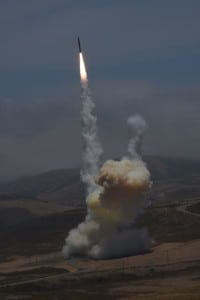The Missile Defense Agency (MDA) laid out the schedule for the Next Generation Interceptor (NGI) and lessons learned from the failure of the Redesigned Kill Vehicle (RKV) in the Defense Department’s fiscal year 2021 budget request Monday.
During a press conference, Michelle Atkinson, MDA Director for Operations, noted the agency is requesting $4.9 billion for NGI funding over the five-year Future Years Defense Program (FYDP). Of that total, $638 million is in the agency’s Research, Development, Test, and Evaluation (RDT&E) account for FY ’21.

The NGI became the successor to RKV interceptors for the Ground-based Midcourse Defense U.S.-based missile defense system when Under Secretary of Defense for Research and Engineering Mike Griffin canceled RKV after a review determined deficiencies would add up to $600 million in additional funding and delay it another two years.
MDA had planned to install 20 new interceptors topped with RKVs at the GMD’s main site at Fort Greeley, Alaska.
According to the agency’s budget estimates overview document, the FY ’21 request would fund initial requirements analysis, design, development, prototyping, and environmental testing to mature the booster, payload, sensors, and design-specific critical technologies.
The agency does not plan to shift NGI funding into procurement accounts until it is ready to build the missiles.
“Once we award the contract and understand the achievable schedule and procurement timeline, then we will change those numbers if need be,” Atkinson added.
MDA Director Vice Adm. Jon Hill explained at the press conference they expect to release the NGI Request for Proposals (RFP) to industry by the end of the month.
“So after we put out the RFP then there’s a specific amount of time…where we do the technical evaluation on the bids that come in and then we’ll make the award at the end of the year,” he said.
The MDA budget estimates overview said the agency will continue design and development activities for two competitive interceptor development contracts scheduled to be awarded in July 2020.
Hill underscored MDA is funded to have two suppliers “for risk reduction through at least preliminary design review,” an element added as a lesson learned from the RKV.
“So you’ve got a competition in place, we have the ability now to carry two, so the Department has supported that, help do the risk reduction piece and then we’ll pick the right point in time to do downselect.”
Hill said the MDA is requesting funding through the preliminary design review (PDR) “and there’s plenty of arguments out there that you’ve got to go all the way to the [critical design review], so we’ll have that conversation when the time is right.”
Depending on what options industry gives MDA, Hill said they expect to start testing in 2025-26 and only start adding them into the silos at Fort Greely by 2027-28 and beyond.
Hill added the agency has learned several lessons from the RKV failure that cost upward of $1.2 billion. This will be the first time the agency has “really taken a holistic look at the full range of requirements” for a GMD interceptor.
He explained RKV “was always meant to be a manufacturing and production improvement to the current GBI” that would allow the agency to build more interceptors quickly.
In contrast, with NGI, MDA is looking at all requirements across the operation space, from natural to man-made as the threat and capabilities of adversaries like North Korea evolves.
Coordinating closely with U.S. Northern Command and Strategic Command, the program has cleared an operational forces standing committee and is scheduled for a Joint Requirements Oversight Council on Tuesday. After the release of the RFP by the end of the month, MDA will receive feedback from industry, which “has been very responsive” on the NGI effort.
Last August, MDA disclosed it was briefing industry on a draft RFP for NGI at Redstone Arsenal in Huntsville, Ala. (Defense Daily, August 27, 2019).
“Now the question is what will they build and what’s the timeline and what will we select in the endgame. So our intent is to go to award by the end of the year,” Hill added.